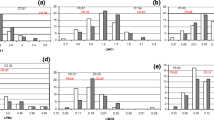Summary
Interspecific segregating populations derived from a cross between tomato (Lycopersicon esculentum) cv ‘M82-1 -8’ (M82) and the wild species L. pennellii accession LA-716 (Lpen716) were used to study the genetic basis of salt tolerance and its implications for breeding. BC1 (M82 x (M82 x Lpen716)) and BC1 S1 (progenies of selfed BC1 plants) populations were grown under arid field conditions and irrigated with water having electrical conductivities of 1.5 (control), 10 and 20 dSm-1. The evaluation of salt tolerance was based on total fruit yield (TY), total dry matter (TD) and TD under salinity relative to the control (RD). Sodium, potassium and chloride concentrations were measured in the leaves and stems. The methods for estimating heritability were adapted to BC1 plants and BC1S1 families. TY, TD and RD had heritability estimates of 0.3–0.45, indicating that salt tolerance can be improved by selection. Genetic correlations between traits indicated that high yield may be combined with salt tolerance and that ion contents are not likely to provide an efficient selection criteria for salt tolerance. Genetic correlations between performances under various salinity levels suggested that similar mechanisms affect the responses to salinity treatments of 10 and 20 dSm-1. Responses to “paper” selection confirmed that salt tolerance of the tomato may be improved by selection, and that this selection should be based on dry matter and yield parameters under salinity.
Similar content being viewed by others
References
Ashraf M, McNeilly T, Bradshaw AD (1986) Heritability of NaCl tolerance at the seedling stage in seven grass species. Euphytica 35:935–940
Ashraf M, McNeilly T, Bradshaw AD (1987) Selection and heritability of tolerance to sodium chloride in four forage species. Crop Sci 227:232–234
Cahaner A, Hillel J (1980) Estimating heritability and genetic correlation between traits from generations F2 and F3 of self-fertilizing species: a comparison of three methods. Theor Appl Genet 58:33–38
Eshed Y, Abu-Abied M, Saranga Y, Zamir D (1992) Lycopersicon esculentum lines containing small overlapping introgressions from L. Pennellii. Theor Appl Genet (in press)
Falconer DS (1981) Introduction to quantitative genetics. Longman, London
Finlay KW, Wilkinson GN (1963) The analysis of adaption in a plant breeding programme. Aust J Agric Res 14:742–754
Jones RA (1986) The development of salt-tolerant tomatoes: Breeding strategies. Acta Hortic 190:101–114
Jones RW (1984) Studies related to genetic salt tolerance in the cucumber, Cucumis sativus L. Diss Abstr Int B 45:1376B
Lyon CB (1941) Responses of two species of tomatoes and the F1 generation to sodium sulfate in the nutrient medium. Bot Gaz 103:107–122
Mather K, Jinks JL (1971) Biometrical genetics, the study of continuous variation. Chapman and Hall, London
Moeljopawiro S, Ikehashi H (1981) Inheritance of salt tolerance in rice. Euphytica 30:291–300
Norlyn JD (1984) Ion absorption and antogeny in relation to the heritability of salt tolerance in barley. Diss Abstr Int B 44:2027B
Ray AA (ed) (1982) SAS user's guide: statistics. SAS Institute, Cary. N.C.
Rosielle AA, Hamblin J (1981) Theoretical aspects of selection for yield in stress and non-stress environments. Crop Sci 21:943–946
Saranga Y, Marani A, Zamir D, Rudich J (1991) Breeding tomatoes for salt tolerance: Field evaluation of Lycopersicon germplasm for yield and dry matter production. J Am Soc Hortic Sci 116:1067–1071
Saranga Y, Marani A, Zamir D, Rudich J (1992) Breeding tomatoes for salt tolerance: Variations in ion concentration associated with response to salinity. Hortscience (in press)
Steel RGD, Torrie JH (1980). Principles and procedures of statistics, a biometrical approach. McGraw-Hill, New York
Turner HN, Young SSY (1969) Quantitative genetics in sheep breeding. Cornell University Press, Ithaca, N.Y.
Author information
Authors and Affiliations
Additional information
Communicated by A. R. Hallauer
Passed away May 1986
Rights and permissions
About this article
Cite this article
Saranga, Y., Cahaner, A., Zamir, D. et al. Breeding tomatoes for salt tolerance: inheritance of salt tolerance and related traits in interspecific populations. Theoret. Appl. Genetics 84, 390–396 (1992). https://doi.org/10.1007/BF00229498
Received:
Accepted:
Issue Date:
DOI: https://doi.org/10.1007/BF00229498




